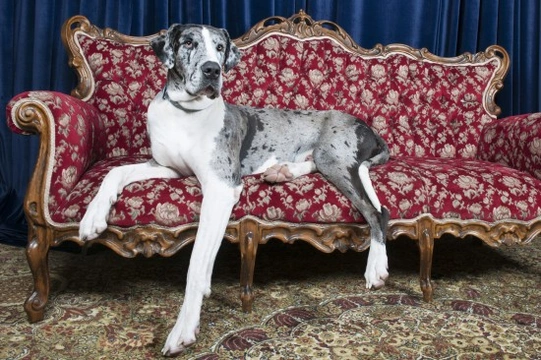
Correctly feeding a Great Dane dog
The Great Dane is one of the giant dog breeds, and they are among the tallest dog breeds in the world, with the Irish Wolfhound being the only other breed that reliably grows taller than them. They are also relatively sturdily built with a deep chest, but they are generally lighter weight than many of the other giant dog breeds such as the Newfoundland dog or the St. Bernard.
Feeding any giant breed of dog can prove to be a challenge, as well as a rather costly endeavour, due to the sheer volume of food that these big dogs require in order to thrive! However, feeding the Great Dane should be undertaken with even more care than most other giant dog breeds, due to their unique nutritional requirements, and rather heightened propensity to developing digestive conditions such as bloat and GDV (gastric dilation volvulous), both of which are extremely painful and can potentially prove fatal.
Read on to learn all about how to correctly feed your Great Dane throughout their life.
What influences the dietary needs of the Great Dane?
Like any dog breed, the Great Dane should be fed an appropriate diet for their life stage and general needs, and these needs will change throughout their lives. The Great Dane puppy will require a large breed puppy food, and as the Great Dane is a relatively slow growing dog, they may require a special diet to support growth up until they are around eighteen months to two years of age, rather than the one year of age at which smaller breeds usually go on to adult foods.
What, when and how you feed will also be influenced by other factors, such as how active your dog is, and whether or not they are spayed or neutered. As they are such big dogs, picking a food suitable for their size is important too, with larger chunks of kibble and diets specially prepared to support the nutritional needs of giant dogs highly recommended.
Feeding Great Dane puppies
Great Dane puppies will continue to grow physically until they are around 18 months old, and you will need to adjust their diet progressively during this time to account for their changing needs. Precisely how much food your Great Dane puppy will need to eat during each month of their puppyhood will vary depending on the size and development of your dog, and the feeding guidelines provided with their food.
It is important to divide up your puppy’s meals into portions throughout the day, rather than feeding it all in one big meal. Until your puppy is at least nine months old, feed them three times a day, and when they reach nine months to one year old, you can, if you wish, start to re-divide their rations into two meals per day, if this is how you intend to feed them once they reach adulthood.
Any changes of this sort should be made gradually, with the feeding of the third meal phased out and the remaining two meals made larger over the course of a week or two.
Monitor your puppy’s growth and development, weighing them on a monthly basis. It is of course important to ensure that they get the right amount of food to support growth, but do not overfeed your puppy, as this will set the standard for the rest of their adult lives. You should be able to feel your puppy’s ribs by running your hand lightly along their flank, but the ribs should not be clearly visible.
Feeding Great Dane adult dogs
Feeding twice per day is recommended for adult Great Danes, and simply feeding one large meal per day is not appropriate for the Great Dane or any other dog. If you can set a routine of feeding three meals per day rather than two, this is fine as well. While you will usually be able to get into a set routine of how much you feed your dog per meal, remember that this process should be constantly under review, and adjusted depending on your dog’s life stage and activity levels.
General feeding tips
Always measure out your dog’s food, and do not free-feed by leaving food down at all times. Stick to set mealtimes so that your dog comes to know when they will be fed, and so that their digestive system will fall into a natural feeding routine.
Monitor the amount of treats that you give to your Great Dane, and ensure that they are fed proper, nutritionally complete meals and not table scraps and salty or sugary treats.
Ensure that your dog is given plenty of time to digest their food before exercising; at least two hours after a meal before exercise or vigorous play is recommended in order to minimise the likelihood of digestive upsets or bloat.



